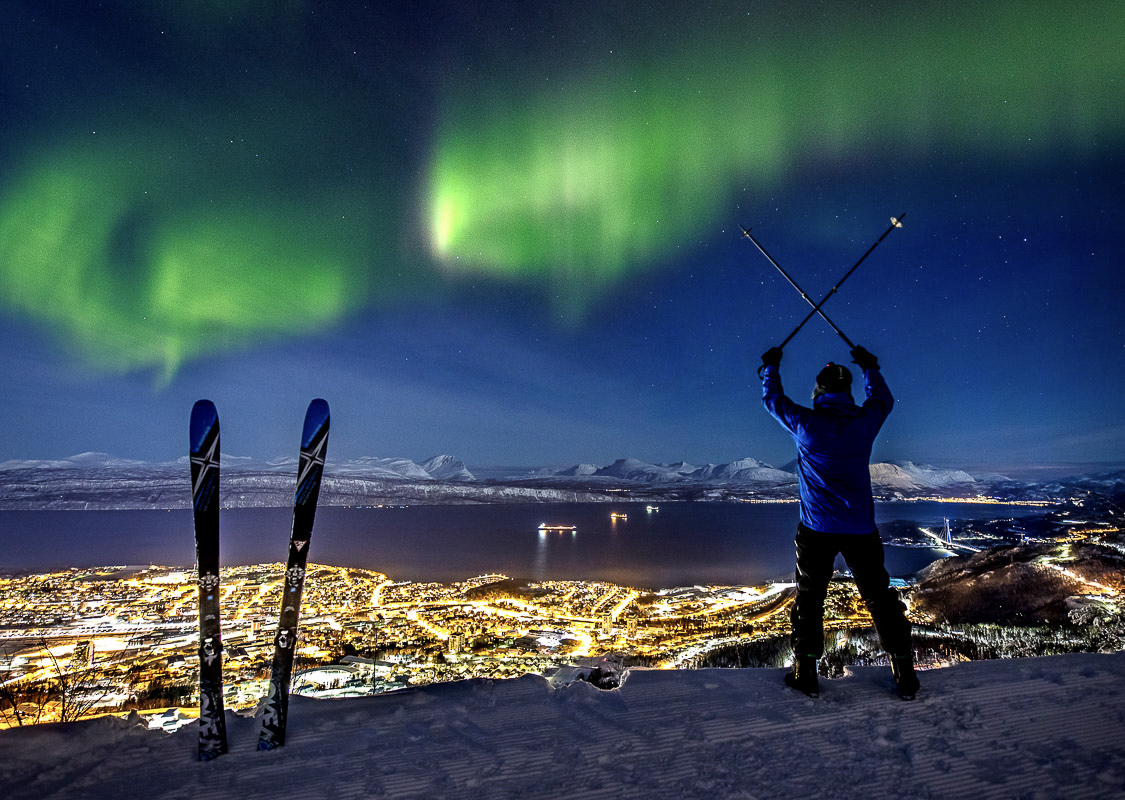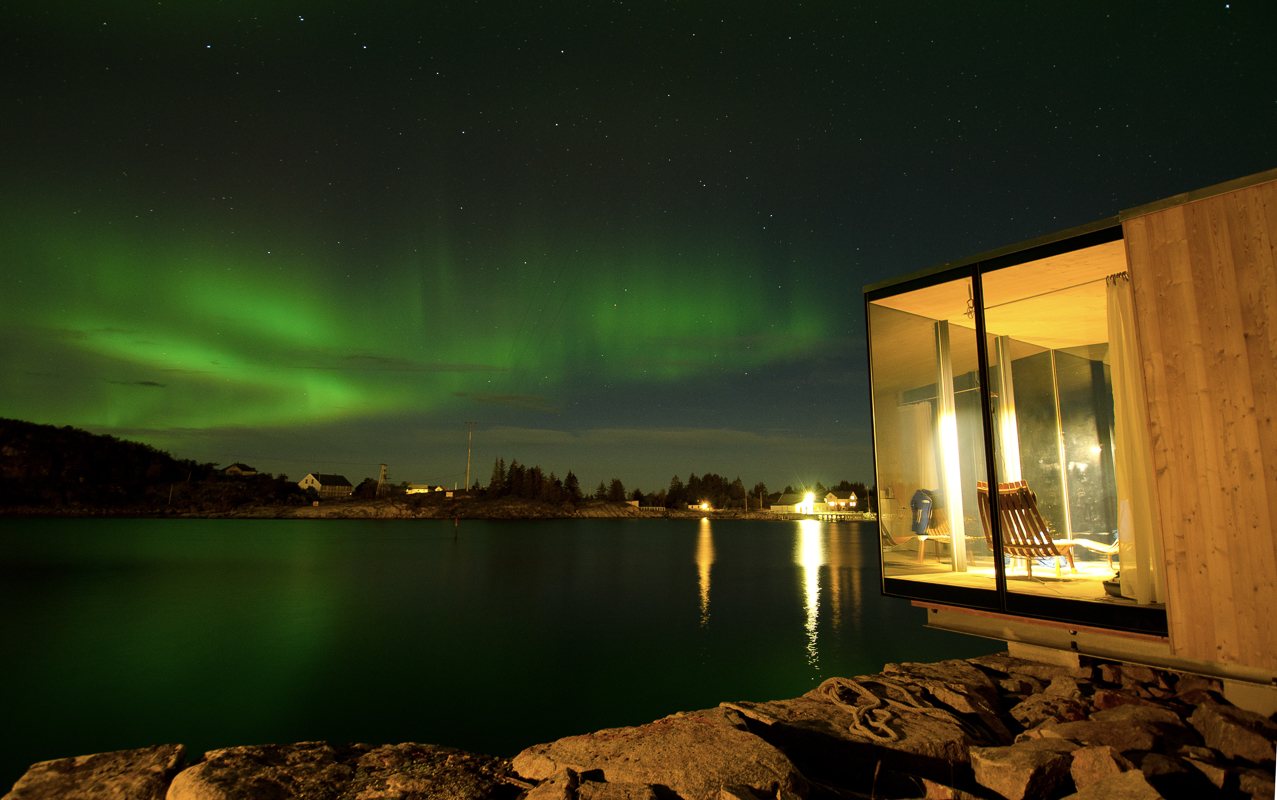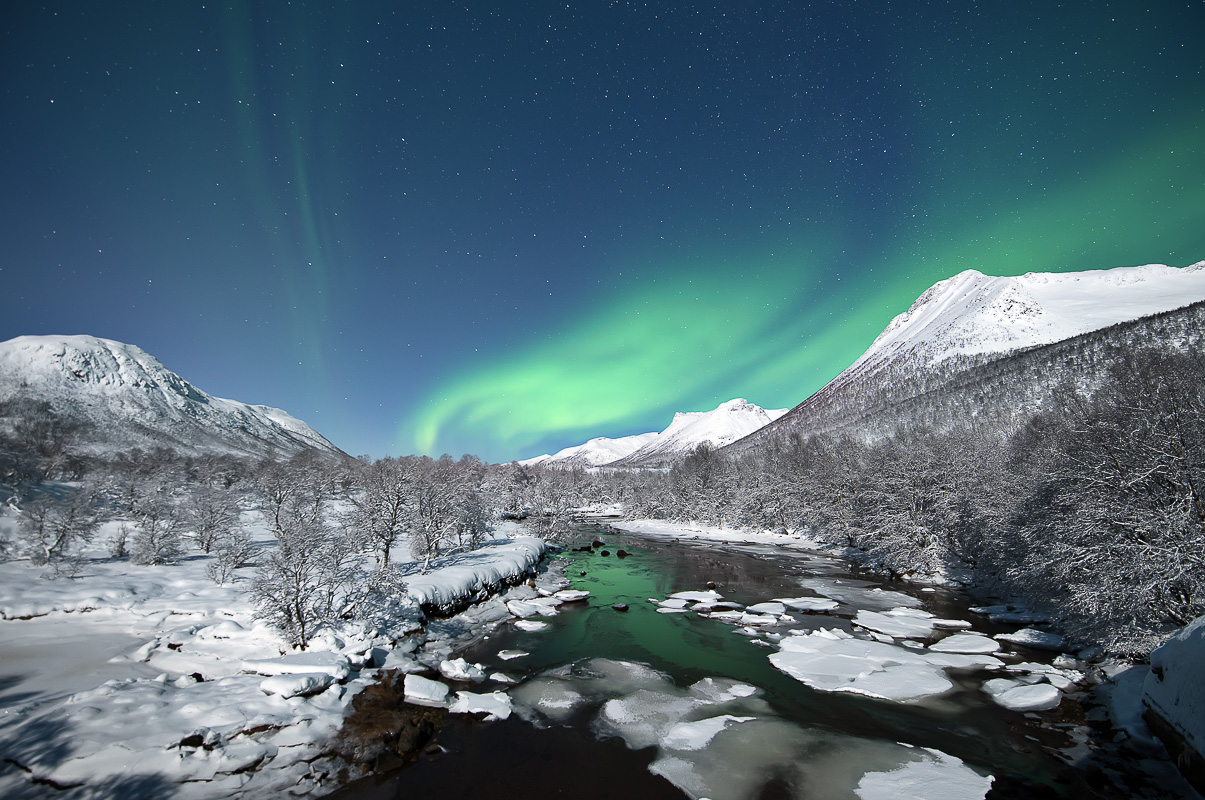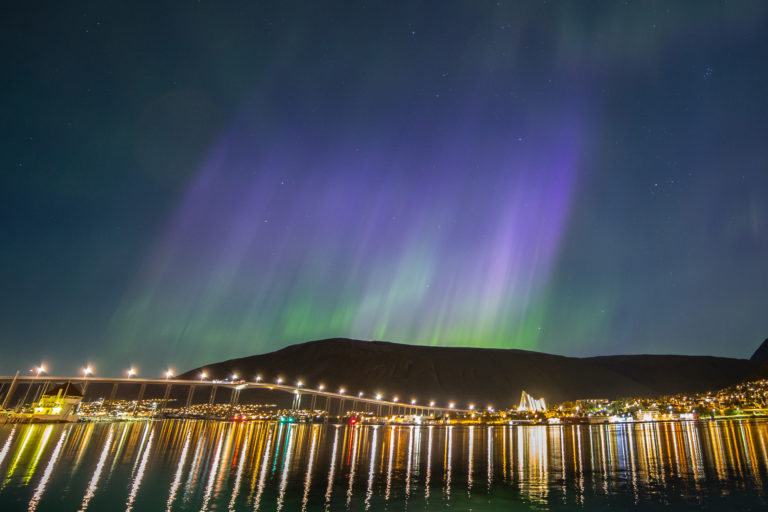A light-footed dance, billowing curtains, arches and ribbons in a supernatural green colour. On occasion, the sky explodes into a kaleidoscope of green, white, pink and violet for a seemingly endless second. Down on the solid ground, we pinch ourselves and ask whether we did actually see what we just saw. Northern Norway is one of the best places in the world to watch the majestic Northern Lights.
Northern Norway is among the areas of the globe that are under the Northern Lights oval, and consequently have the most Northern Lights. This northern region is also easy to travel to, has good infrastructure and the mildest climate in the Arctic. For the traveller, the Northern Lights can easily be combined with fun outdoor activities, a fascinating heritage and getting to know the locals.
What are the Northern Lights?
What are the Northern Lights?
The Northern Lights are born on the Sun. Electrically charged particles are catapulted off the surface of the Sun in the aftermath of powerful solar storms. Some of these particles travel towards Earth. When they reach the planet, they are conducted along the protective magnetic fields towards the magnetic North and South Poles. In a ring-shaped pattern around the magnetic poles, the particles encounter the upper layers of the atmosphere. In a process identical to the one that occurs inside a fluorescent light, energy is released as light that we can observe from the Earth. Most Northern Lights “displays” take place at a height of around 100-300 km above the Earth’s surface.
What do the Northern Lights look like?
The Northern Lights appear in a range of shapes: as billowing “curtains”, as undulating ribbons and as rolling banks of smoke. They are usually bright electric green in colour, often with a slim pink stripe on the underside. Occasionally, the Northern Lights explode in a corona, with rays shooting in all directions across the entire sky in shades of green, violet, white and pink. There are some differences between what you see with your bare eye, and what type of colours a proper camera would pick up. You may learn how to photograph Northern Lights here.
Photographing the Aurora like a pro?
Northern Norway is in the heart of the Northern Lights belt!
The Northern Lights belt stretches along the coast of Northern Norway from Lofoten to the North Cape. The altitude is typically around 100 – 300 km high, meaning it can be seen much further afield than the mentioned regions. This means that Northern Norway is the perfect place to observe this natural phenomenon. In fact, the Northern Lights are more commonly seen here than anywhere else in the world. Svalbard (Spitsbergen) is a little farther from this belt, but here you can see the daytime Northern Lights in mid-winter.
Facts about the Northern Lights
The Northern Lights originate on the sun during periods of high solar activity. Solar particles move towards Earth and follow invisible magnetic lines down into the atmosphere where they react with gasses, creating the Northern Lights. The Northern Lights are seen across the polar regions under an area called the auroral oval. The auroral oval stretches over Northern Norway, Northern Iceland, Canada, Alaska and Northern Russia.
The Northern Lights appear in a range of shapes: as billowing “curtains”, as undulating ribbons and as rolling banks of smoke. They are usually bright electric green in colour, often with a slim pink stripe on one side. Occasionally, the Northern Lights explode in a corona, with rays shooting in all directions across the entire sky in shades of green, violet, white and pink.
The Northern Lights can appear at any time, but they usually grace the sky between 6 o’clock in the evening and 1 o’clock in the morning. It is rare to see the Northern Lights before 18. 00 / 6 pm, even during the darkest months in the Arctic. The highest frequency is around 22:00-23:00 / 10-11pm. After around 1 o’clock in the morning, your chance of seeing the Northern Lights diminishes.
Every Northern Lights evening is different. But if you see the lights at 7pm, chances are they show up, maybe stronger, later in the evening. But no guarantees can be given.
The Northern Lights can appear at any time when it is dark. But, after around 1 o’clock in the morning, your chance of seeing the Northern Lights diminishes.
From mid September to the first days of April, it gets dark at around 6-7pm or earlier. This means that the whole timespan when the Northern Lights are most likely to show up, are in the dark. A first time visitor should come in this timespan. However, the first Northern Lights show up as early as mid August, and sometimes we see the last around May Day. For the advanced Northern Lights photographers, these shoulder periods are of particular interest, as one can photograph the Northern Lights against the sunset. However, the chances to actually see the lights in this period are slimmer, as there is daylight in some of the best Northern Lights hours.
In autumn (around the 21st of September) and spring (around the 21st of March), the earth and the sun and aligned in the right way for the solar winds to hit the magnetic field more directly. Compare it with holding your glass asquew when pouring Fanta. This means that in late September/early October and late March, Northern Lights can be particularly strong. Equally strong Northern Lights can be observed all through the season, though, because of other phenomenons. Feel free to read our article.
The Northern Lights oval goes around the globe
The Northern Lights zone, or oval, goes around the globe. As the globe spins, new locations are blessed with the mesmerising green rays. After Northern Norway, the lights move on to Iceland, then to Greenland and then on to parts of Northwestern Canada and Central Alaska. Some places along the Northern coast of Siberia are good observation points too. Parts of Sweden and Finland are very close to Northern Norway, and can see the same eruptions as one can observe in Northern Norway, just at a different angle.
Svalbard has daytime Northern Lights
The archipelago of Svalbard, an hour and a half by plane north of the Northern Norwegian mainland, can offer a Northern Lights speciality; the daytime Northern Lights. This phenomenon occurs in late November, December and January, the period when Svalbard has no daylight at all. The daytime lights come directly from the sun in the middle of the day, whereas the “normal” Northern Lights on the mainland have made a detour to the nightside of the planet before hitting the atmosphere.
Clear skies are essential!
Weather conditions also play an important role as clear skies are essential. A solid cloud cover, maybe with snow or rain, means you cannot see the Northern Lights. The regions further inland, hidden from the ocean by high mountain ranges, generally have a more stable climate with more cloudless nights. When the cold eastern winds blow in the winter, though, conditions are clearest along the coast. Everywhere in Northern Norway, the weather can vary within a few kilometres, so being mobile is a very good idea.
When during the day can you see the Northern Lights?
The Northern Lights can appear at any time, but they usually grace the sky between 6 o’clock in the evening and 1 o’clock in the morning.You can be lucky and see them before or after, but to maximise your chances, you should concentrate on this time span. The hour between 10pm and 11pm (11pm-midnight when daylight saving time is observed) is statistically the best hour. If you are lucky to see the Northern Lights around 6-7pm, it often means that there is more to come later in the evening. Cancel dinner, and stay out!
Light pollution disturbs the Northern Lights
The Northern Lights are faint and ethereal, so they cannot compete with neon and car headlights. Therefore, find a place without light pollution. City lights disrupt your night vision.If you are in a town, find a dark area or a high vantage point. If there is a big eruption, you can stand in the middle of Bodø or Tromsø (the northern metropolises) and watch them. You risk to miss the smaller ones, though. If you are close to a town, find a place north of the built-up area as the faint Northern Lights typically appear on the northwestern horizon.
Is the full moon a problem?
The moon and the Northern Lights are of course two different entities, independent of each other. Northern Norwegian photographers are often out in full moon nights, since it can be easier to adjust the camera. The landscape is also lit up, so one can get better photos. So a full moon should not stop you from chasing the Northern Lights.
When during the year is it best to see the Northern Lights?
You can see the Northern Lights when it’s dark. Northern Norway has no night for months on end, so when the Midnight Sun shines, there is no chance of spotting the Northern Lights. However, as soon as night falls, the phenomenon is observed. The first lights are often observed around mid – late August, and as the nights get longer, the window of opportunity widens. From around mid September to the end of March, it gets dark at six or earlier. This means you have maximum chances. A good week after spring equinox, around the first of April, daylight is gradually eating into the good hours. By late April, the Northern Lights have been completely outdone by daylight. Solar activity can be measured at the observatories, but nothing can be seen.
A tour with a Northern Lights guide maximises your chances
If you join a guided tour with an experienced Northern Lights guide, you have the best chances of spotting the Northern Lights. This is because of the weather. If you are mobile, you can move away from the clouds and find areas with clear skies. The guide is usually an expert on reading weather charts, she’s got connections around the area and makes phone calls. Maybe the snow clouds are only on this side of the mountain and the stars shine on the other side? If you have limited time, a Northern Lights guide can be essential in finding the lights.
Should I take the longest tour possible?
Maybe you have heard about guided tours that set out at 6pm, and return at 4 in the morning? This can happen on a night with difficult weather, and long, dark minibus drives are involved. If you have little time and really want to see the lights, these tours give the highest probability. However, many people in a holiday mood find them too long. There are other tours that start at 7-8pm and finish around midnight. There are also tours going to “basecamps”, where hot drinks and toilet facilities are included, and you can ski or snowshoe white you wait. Read the programmes well, and decide how much time you want to invest in the Northern Lights hunt.
Being active is the fun way of waiting for the Northern Lights
To many people, a minibus chase of the Northern Lights sounds like no fun. Instead, one wants to be active. In winter, there are a number of dogsledding trips, snowmobile expeditions, snowshoe walks, ski trips and ice fishing outings available, depending on where you are. Dogsledding is learned in about 30 seconds, and inner city Londoners appear as pros after the first three turns.
Can I see the Northern Lights without going on a tour?
There are many ways you can watch the Northern Lights on your own. The easiest is to go for a long walk at night. There are, however, some hazards. Make sure you have reflectives when you walk along a road. Nights can be cold in winter, so you need a lot of clothes. You can also rent skis and go for a spin in the local cross country ski track, there is one in almost any town and village in Northern Norway.
Hiking with a headlamp is the thing in Autumn
More and more people realise that Autumn is a good time to come for the Northern Lights. In September-October, mountains are often snow-free, and you can go hiking. In some destinations, there are guided hikes at night. You can also ask the local tourist board for a recommended hike suited to your level. Have good shoes, a headlamp and a backback for extra clothes, and you’re set.
Northern Lights from Home
Go Northern Lights hunting by car on your own
If you are used to driving in Winter, you can rent a car and go on your own. Ask the tourist information to check the weather chart, and work out a little plan. Pack extra clothes, get hold of a reflective vest, and drive into the night. Make frequent stops at safe places, buy coffee at petrol stations and explore the night landscape around. This can be a fun way of doing it.
Rent your own holiday home for the Northern Lights
To some, both organised Northern Lights chases and nocturnal dogsledding sound like way too much work. Instead, they rent a holiday home and relax for a long week-end or a whole week. Go for a walk, visit the cafes where the locals go, read a book and look out the window. After 6pm, the evening is consecrated to waiting for Aurora. Holiday homes come in all shapes; the traditional rorbu (fisherman’s shacks) with or without mod-cons, modern bungalows, charming old farmhouses, glass igloos, light houses, modern huts praised in international architect’s magazines… the variation is endless.
Where in Northern Norway should I go to see the Northern Lights?
Most of Northern Norway has excellent chances of spotting the lights. In fact, we often see the same lights all over Northern Norway. In Svalbard, they are spottet in the south, in Tromsø and Lofoten they are overhead, and in Helgeland they blanket the northern sky. All at the same time. Your choice of destination depends on how you want to experience them. Places like Alta, Kirkenes and Svalbard are for the adventurous who like to do plenty of snow activities. The Northern Lights on the North Cape is a check on the bucket list for the spoilt globetrotter. Tromsø is both arctic-urban and has a grand selection of tours. The fabulous landscapes of Lofoten and Vesterålen are easily explored even at night. Bodø, the Salten area and Helgeland see few Northern Lights tourists in winter, and are thus for those seeking solitude.
How do I photograph the Northern Lights?
Night photography is among the most difficult kinds of photography. For good Northern Lights photography, it takes a camera with manual functions. If you put your camera on M for manual, adjust your lens to be sharp against stars on the nightsky, adjust the ISO on 1200 and have a shutter speed on 5-10 seconds, you should be able to get a good photo. You also need a steady tripod, you cannot hold the camera for 5-10 seconds and expect a good photo. Does this sound Greek to you? Read our article on how to take photographs in the dark, and you’ll be a lot wiser.
Fun facts about the Northern Lights
Indeed, the Aurora Australis. Exactly the same things happen in the Southern Hemisphere. However, the most intense areas of Southern Lights are either on the coast of Antarctica or in the Southern Ocean, and are observed by leopard seals and penguins only. The Southern Lights are observed in New Zealand and in Tasmania with some frequency. Northern Light geeks in fact go there to see the red auroras that tower into the night sky. However, you need a solid solar storm.
Northern Lights are not only restricted to the areas under the Northern Lights oval, such as Northern Norway. They are often observed in Southern Scandinavia, notably in Oslo and Stockholm. When there is a particularly strong solar storm, the lights can be observed both in Central and Southern Europe, occasionally down to the tropics. However, in Northern Norway, they can be observed around 90% of every clear night. In Oslo, you can expect to see them around once a month, provided you get out of the city lights. In Barcelona, they are observed around every 11th year. I heard a story of how they were observed during the Spanish civil war, because the lights were out!
No. The Northern Lights have throughout history varied in intensity. The Northern Norwegian poet Petter Dass (1647–1707) mentions various things about Northern Norway in his works, but not the Northern Lights. It is likely that the Northern Lights never appeared during his lifetime. This lack of activity is by many scientists seen as correlating with the colder climate of the 17th and 18th century, known as the “little ice age”.
People in central and southern Europe saw a lot more Northern Lights before the advent of electric lights than they do today. Thus, astronomers and scientists like Galileo Galilei (1564-1642) could observe a red light in the north at night. In a big Northern Lights eruption over Norway, the Northern Lights can be very high up, maybe 800 km above ground. That means they could be seen all the way down to Italy. However, because of the curved globe, they could only see the top part, which is red. The green main body and pink lower fringe were hidden below the horizon. Galileo Galilei consequently named the red light he saw “the northern morning red”, Aurora Borealis. Aurora is the goddess of the morning red in Roman mythology.
Kids in Northern Norway often tell each other (or was that an old uncle?) that one shouldn’t whistle at the Northern Lights, or wave at it with a white hankerchief. Then the Northern Lights would come and carry you away. Of course, no kid can resist the temptation (at least I couldn’t), so I think we can safely assume that such activities represent no major danger.
We often read, almost exclusively from non-Sami sources, that the Sami word for Northern Lights, guovssahas, means “the lights you can hear”. Unfortunately, we don’t speak Sami too well, so to be sure we rang up professor emeritus at the Sámi Allaskuvla/Sami University of Applied Sciences, and the first president of the Sami Parliament, Mr. Ole Henrik Magga. He said that guovssahas is probably derived from guovssu, which means dawn. And the Northern Lights can look like the dawn when they are strong. Okay, that explanation is a bit less colourful, but at least it is correct.






